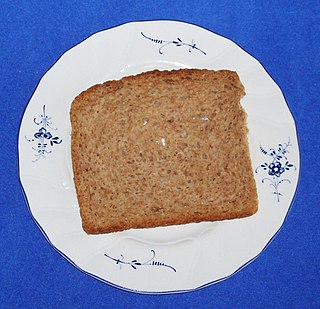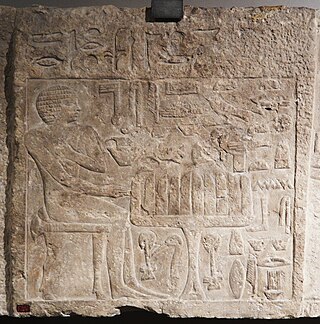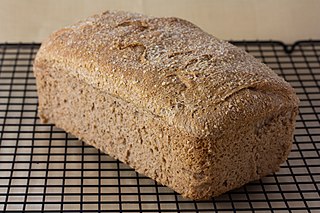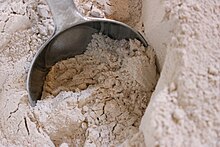
Flour is a powder made by grinding raw grains, roots, beans, nuts, or seeds. Flours are used to make many different foods. Cereal flour, particularly wheat flour, is the main ingredient of bread, which is a staple food for many cultures. Corn flour has been important in Mesoamerican cuisine since ancient times and remains a staple in the Americas. Rye flour is a constituent of bread in central and northern Europe.

Graham bread is a name for whole wheat bread that was inspired by the teachings of famous health reformer Sylvester Graham.

White bread typically refers to breads made from wheat flour from which the bran and the germ layers have been removed from the whole wheatberry as part of the flour grinding or milling process, producing a light-colored flour. This milling process can give white flour a longer shelf life by removing the natural oils from the whole grain. Removing the oil allows products made with the flour, like white bread, to be stored for longer periods of time avoiding potential rancidity.
Wheat flour is a powder made from the grinding of wheat used for human consumption. Wheat varieties are called "soft" or "weak" if gluten content is low, and are called "hard" or "strong" if they have high gluten content. Hard flour, or bread flour, is high in gluten, with 12% to 14% gluten content, and its dough has elastic toughness that holds its shape well once baked. Soft flour is comparatively low in gluten and thus results in a loaf with a finer, crumbly texture. Soft flour is usually divided into cake flour, which is the lowest in gluten, and pastry flour, which has slightly more gluten than cake flour.
Enriched flour is flour with specific nutrients returned to it that have been lost while being prepared. These restored nutrients include iron and B vitamins. Calcium may also be supplemented. The purpose of enriching flour is to replenish the nutrients in the flour to match the nutritional status of the unrefined product. This differentiates enrichment from fortification, which is the process of introducing new nutrients to a food.

The germ of a cereal grain is the part that develops into a plant; it is the seed embryo. Along with bran, germ is often a by-product of the milling that produces refined grain products. Cereal grains and their components, such as wheat germ oil, rice bran oil, and maize bran, may be used as a source from which vegetable oil is extracted, or used directly as a food ingredient. The germ is retained as an integral part of whole-grain foods. Non-whole grain methods of milling are intended to isolate the endosperm, which is ground into flour, with removal of both the husk (bran) and the germ. Removal of bran is aimed at producing a flour with a white rather than a brown color, and eliminating fiber, which reduces nutrition. The germ is rich in polyunsaturated fats and so germ removal improves the storage qualities of flour.

Rye bread is a type of bread made with various proportions of flour from rye grain. It can be light or dark in color, depending on the type of flour used and the addition of coloring agents, and is typically denser than bread made from wheat flour. Compared to white bread, it is higher in fiber, darker in color, and stronger in flavor. The world's largest exporter of rye bread is Poland.
Indian breads are a wide variety of flatbreads and crêpes which are an integral part of Indian cuisine. Their variation reflects the diversity of Indian culture and food habits.

Pain de campagne, also called "French sourdough", is typically a large round loaf ("miche") made from either natural leavening or baker's yeast. Most traditional versions of this bread are made with a combination of white flour with whole wheat flour and/or rye flour, water, leavening and salt. For centuries, French villages had communal ovens where the townsfolk would bring their dough to be baked, and the loaves weighed from 1.5 to 5.5 kilograms (3–12 lb). Such large loaves would feed a family for days or weeks, until the next baking day.

Maida is a white flour from the Indian subcontinent, made from wheat. Finely milled without any bran, refined, and bleached, it closely resembles cake flour. Maida is used extensively for making fast foods, baked goods such as pastries, bread, several varieties of sweets, and traditional flatbreads. Owing to this wide variety of uses, it is sometimes labeled and marketed as "all-purpose flour", though it is different from American all-purpose flour.

A dough conditioner, flour treatment agent, improving agent or bread improver is any ingredient or chemical added to bread dough to strengthen its texture or otherwise improve it in some way. Dough conditioners may include enzymes, yeast nutrients, mineral salts, oxidants and reductants, bleaching agents and emulsifiers. They are food additives combined with flour to improve baking functionality. Flour treatment agents are used to increase the speed of dough rising and to improve the strength and workability of the dough. While they are an important component of modern factory baking, some small-scale bakers reject them in favour of longer fermentation periods that produce greater depth of flavour.

Sprouted bread is a type of bread made from whole grains that have been allowed to sprout, that is, to germinate, before being milled into flour. There are a few different types of sprouted grain bread. Some are made with additional added flour, some are made with added gluten, and some, such as Essene bread and Ezekiel bread, are made with very few additional ingredients.

The Great Harvest Bread Company is a franchise in the United States that sells fresh-baked bread and other items.

Bread was central to the formation of early human societies. From the Fertile Crescent, where wheat was domesticated, cultivation spread north and west, to Europe and North Africa, and east towards East Asia. This in turn led to the formation of towns, as opposed to the nomadic lifestyle and gave rise to more and more sophisticated forms of societal organization. Similar developments occurred in the Americas with maize and in Asia with rice.

Whole wheat bread or wholemeal bread is a type of bread made using flour that is partly or entirely milled from whole or almost-whole wheat grains, see whole-wheat flour and whole grain. It is one kind of brown bread. Synonyms or near-synonyms for whole-wheat bread outside the United States are whole grain bread or wholemeal bread. Some regions of the US simply called the bread wheat bread, a comparison to white bread. Some varieties of whole-wheat bread are traditionally coated with whole or cracked grains of wheat, though this is mostly decorative compared to the nutritional value of a good quality loaf itself.
A Unifine mill is a single one-pass impact milling system which produces ultrafine-milled whole-grain wheat flour that requires no grain pre-treatment and no screening of the flour. Like the grist or stone mills that had dominated the flour industry for centuries, the bran, germ, and endosperm elements of grain are processed into a nutritious whole wheat flour in one step. Consumers had accepted whole wheat products produced by grist or stone mills. The flour produced by these mills was quite coarse as they included the bran and the germ elements of the grain.

A baking mix is a mixed formulation of ingredients used for the cooking of baked goods. Baking mixes may be commercially manufactured or homemade. Baking mixes that cater to particular dietary needs, such as vegan, gluten-free, or kosher baking mixes, can be bought in many places.
Graham flour is a type of coarse-ground flour of whole wheat named after Sylvester Graham. It is similar to conventional whole-wheat flour in that both are made from the whole grain, but graham flour is ground more coarsely. It is not sifted ("bolted") with a flour dresser after milling. A report from 1913 claimed that bread made from graham flour had a protein content of 12.1% – only slightly less than white wheat flour and essentially the same as whole wheat flour.
The Roller Mill was created by Hungarian bakers in the late 1860s and its popularity spread worldwide throughout the 1900s. Roller mills now produce almost all non-whole grain flour. Enriched flour is flour that meets an FDA standard in the United States. Roller milled white enriched flour makes up over 90% of the flour that comes out of the United States.
Flour extraction is the common process of refining Whole Grain Flour first milled from grain or grist by running it through sifting devices, often called flour dressers.













